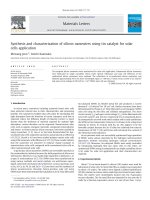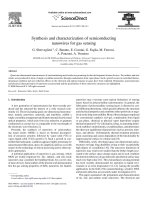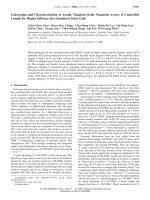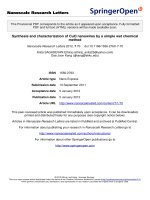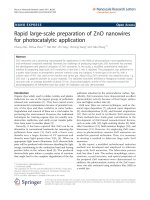Fabrication and characterization of semiconductor nanowires for thermoelectric application 4
Bạn đang xem bản rút gọn của tài liệu. Xem và tải ngay bản đầy đủ của tài liệu tại đây (8.89 MB, 21 trang )
Thermal Conductivity of GeNw and SiNw 72
Chapter 4 Thermal conductivity
characterization of Ge Nanowires
4.1
Introduction
Germanium (Ge) has potential to be used as a thermoelectric material because of its
higher electron mobility (or lower electrical resistivity) and lower thermal conductivity
compared to silicon (Si). The electrical resistivity of bulk Ge is typically about 100
!"cm, about 1000 times less than that of bulk Si. The thermal conductivity of bulk Ge
is 60.2 Wm-1K-1, which is less than half of that of bulk Si. It has been predicted that
semiconductors such as Si and Ge can have a thermal conductivity that is two orders
lower than its bulk value when shrunk to nanoscale dimensions. This work will
investigate the extent to which the thermal conductivity (k) can be decreased in Ge
nanowires produced by the VLS process. The investigation will also show the
feasibility of using the 3! method, which was used in characterizing the thermal
conductivity of carbon nanotubes [7], to measure the k value of the Ge nanowires. Si
nanowires were also fabricated for comparison with the result from Ge nanowires.
4.2
Verification of the 3! method setup with platinum
microwire
When the thermal conductivity of the platinum microwire was initially tested with a
home-made current source circuit with op-amp TL074, capacitors and a few resistors,
there was some problem in obtaining a thermal conductivity that was close to the
theoretical value. Since other researchers who published on the 3# method also used
Thermal Conductivity of GeNw and SiNw 73
platinum microwire of the same diameter to test their setup, the first priority was to
make sure that the setup can measure the thermal conductivity of a platinum microwire
that was close to the theoretical value. Only after the home-made op-amp current
source circuit was replaced with the Keithley 6221 AC and DC current source, the 3!
characterization setup was then able give results of thermal conductivity of the
platinum microwire that match with the theoretical value.
Figure 31 shows the platinum sample that was placed into a CERDIP package. The
contacts were made by silver paste. The whole package was put in an oven and kept at
90"C for 30 minutes to drive out the moisture.
!"#$%&'()'*+,-".$/'/"0%12"%&'3,/4+&'".','56789*'4,0:,#&;'
Thermal Conductivity of GeNw and SiNw 74
Listed below are some theoretical values of platinum which are needed for the thermal
conductivity measurement:
Stefan–Boltzmann constant ! = 5.67*10-8
Emissivity " = 1 (for true blackbody object, <1 for any real object)
Cp (Platinum) = 132.55 J kg-1 K-1
# (Platinum)
(at 300K)
= 21450 kg m-3
Theoretical thermal conductivity k (platinum) = 68 W m-1 K-1
Electrical resistivity #o = 9.8*10-8 !m
(at 273 K)
Room Temperature T = 300 K
Reference temperature To = 273K
Thermal coefficient of resistance $0 = 1/255 K-1
(at 273 K)
Electrical resistivity #e = #o[1 + $o(T - To)]
Therefore,
"e = 9.8 x 10-8 [1 + 1/255 x (300-273)] = 1.08 x 10-7 ! m, and
#e'
= d#e / dT
= #o$o = 4.25 x 10-10 ! m K-1
A platinum microwire with diameter of 20 !m and length of 6 mm was used for the
thermal conductivity measurement. Maximum reserve was selected for the lock-in
amplifier and a working frequency of 1.5 Hz was selected for the current source.
Figure 32 shows the 3! voltage (V3w) versus current bias (I) measurement obtained on
the platinum microwire. Careful selection of the time constant is required to minimize
the noise level and to obtain stable signals. However, too high a time constant would
filter off important signal components. A time constant of 1 second was found to be
suitable for a current bias range of 25 mA to 100 mA because the slope was closest to
theoretical expected value of 3 in the log versus log plot of V3w versus I.
Thermal Conductivity of GeNw and SiNw 75
!"#$%&'()'*(+',-'.'/&0-$%&/&12'31'24&'5602"1$/'/"7%3+"%&'
At I = 80 mA,
measured V3! = 30.15mA.
Substituting all the values from above,
k =
4 I3 L R R’ / [!4 V3w S(1+ (2!")2)0.5]
k =
66.31 W m-1 K-1
where S is the cross sectional area of the specimen , " is the frequency of the current
source, # = L2/(!2$)
and
$ = k/(%Cp).
The measured value is about 2.5% lower than the theoretical value of 68 W m-1 K-1.
This could be due to heat loss to the surrounding environment by radiation or
convection though the residual air molecules in the vacuum chamber. This
Thermal Conductivity of GeNw and SiNw 76
measurement result of the platinum microwire verified that the 3! method thermal
conductivity characterization setup was working.
4.3
Results and discussion
4.3.1 Ge nanowire (GeNw) growth on Si (111) substrate
4.3.1.1 Different GeNw structure fabricated with more Ge powder loaded
The GeNw growth is sensitive to several parameters in the process. For example, Ge
precipitates can be found on the Ge nanowires when the amount of Ge powder used for
the GeNw growth was doubled (see Figure 33). All the other growth conditions
remained the same as the case with normal GeNw growth. A 6 nm thick Au film was
deposited on a Si (111) substrate with resistivity of 0.85-1.15 !"cm. The growth
temperature for the 3 zones (Ge source, center of the quartz tube and the substrates) of
the furnace (as shown in Figure 24(a) in Chapter 3) was 900#C, 450 #C, and 350 #C
respectively, The ramp up time and holding time for the temperature profile (see
Figure 24(b) in Chapter 3) was also 60 minutes each.
As discussed in the literature review section, roughness of the nanowire surface was
found to have a great impact on the thermal conductivity k. Since the rate of
phonon–phonon Umklapp scattering scales as !2, where ! is the phonon frequency,
low-frequency acoustic phonons have long mean free paths and contribute
significantly to k at high temperature [19-22]. The Ge precipitates may contribute to
the surface roughness of the nanowires and act as a form of phonon-scattering
elements at several length scales. If precipitates are incorporated carefully, the k of Ge
Thermal Conductivity of GeNw and SiNw 77
nanowires could decrease dramatically, possibly raising the overall thermoelectric
efficiency provided the electrical conductivity is not adversely affected by the Ge
precipitates. However, the process of how these nanostructures (precipitates) were
formed along the GeNw is not fully understood. It remains of interest to compare the
thermoelectric properties of these wires with properties of standard GeNw without the
Ge precipitates.
!"#$%&'((')&'*%&+"*",-,&.'/0')&'0-0/1"%&.'12&0',2&'-3/$0,'/4')&'*/15&%'./$%+&'1-.'
5/$67&58'
Thermal Conductivity of GeNw and SiNw 78
Unsuccessful GeNw growth with contamination of the Au catalyst
When contamination was introduced to the Au catalyst, the Ge nanowire growth
mechanism can also get disrupted. Although Au is not reactive and it does not react
with most substances at room temperature, Au could still get contaminated. After 6 nm
of Au was deposited on a cleaned Si (111) wafer under the same conditions, the Si
sample was left at room temperature and pressure for two days before the GeNw
growth. All the other conditions and preparation for the nanowire growth was the same
as the normal GeNw growth process. However, the GeNw fabricated were much less
than a normal growth; this was observed in all 4 substrates used in the experiment.
Most of the areas on the Si substrate was bare without much nanowire growth as
shown in Figure 34. Very short and thin GeNw was observed occasionally. The Au
film had agglomerated to form Au colloids but there was minimum nanowire growth.
Some of the Au colloids only showed traces of germanium underneath.
The mystery of how unreactive Au can get contaminated lies in the silicon substrate
that Au was deposited on. After the cleaning process and oxide strip, the Si surface is
in close contact with the Au atoms. Si had probably diffused into the Au layer since Si
outdiffusion into Au is well known [92]. Many chemical models and studies [93]
suggest that the Au atoms bond with the Si atoms (Au-Si surface dangling bonds) for
less than 1 monolayer of Au coverage; for a thicker Au layer, the Au-Si bonds
facilitate Si-Si bond disruption, the diffusion of Si atoms, and the formation of Au-Si
alloy. The presence of Si in the Au layer could result in the formation of a silicon
oxide layer at the gold surface when the Si is subsequently oxidized when left for some
time. The presence of a silicon oxide layer will affect the GeNw growth in the VLS
Thermal Conductivity of GeNw and SiNw 79
process.
Another more direct way of contamination was when the ceramic furnace tube was not
used for a long time and contamination started to accumulate in the furnace tube. Since
the furnace tube was not kept in a vacuum environment during growth, there could be
redeposition of the contaminant particles which get incorporated into the Au colloids.
Therefore, the nanowire growth process should be arranged immediately after the Au
catalyst deposition. Also, the furnace tube and quartz tube must be kept clean for
growth.
!"#$%&'()'*+,'"-.#&'/0'1$'2/33/"4'.54'6.%7".3'8&'5.5/9"%&'#%/97:;'
Thermal Conductivity of GeNw and SiNw 80
Successful GeNw growth
Figures 35 and 36 show the SEM images of GeNw grown successfully. The
temperature of the 3 zones of the growth furnace were ramped up to 900!C, 450!C and
350!C respectively in 60 minutes (see Figure 24 in Chapter 3). The constant
temperature regime was then maintained for 60 minutes. However, it was observed
that other than zone 1 which stayed at 900!C, the temperature of zone 2 and zone 3
continued to rise slowly. At the end of the constant temperature regime, zone 2 and
zone 3 reached a temperature of 538 !C and 423 !C respectively. The higher than
expected temperature could be due to the continued heat transfer from zone 1 by
conduction through the furnace tube and convection of gas in and around the furnace
tube. Therefore, it is important to note the actual temperature of each zone during the
growth process since the actual growth temperature can be very different from the
temperature set for growth.
For the purpose of electrode deposition, longer GeNw would be suitable. Attempts of
fabricating longer wires were made by increasing the duration of the constant
temperature regime of the growth from 60 minutes to 90 minutes. From SEM
examination after growth, longer GeNws were observed. However, the GeNw
observed after dispersing on the oxidized Si substrate was shorter. Also, more clumps
and clusters of GeNws were observed. It was hard to find a single separate GeNw of
suitable length. This was due to the characteristic of GeNws grown by the VLS
process. Typically, the GeNws do not grow in a vertical manner. Even when the
beginning orientation of the GeNw was in the (100) direction, it is very common for
Thermal Conductivity of GeNw and SiNw 81
the GeNw to bend and entangle with one another after the GeNws have attained a
certain length. The entangled GeNws can easily break when they were dispersed in a
sonication bath. The typical length of GeNws after being dispersed ranges from 10 !m
to 38 !m.
!"#$%&'()'*+,'"-.#&'/0'1&234'#%/35'67'89&':;*'<%/=&44>'
Thermal Conductivity of GeNw and SiNw 82
!"#$%&'()'*"#+',-#."/"0-1"2.'345'",-#&'2/'6&789:'
4.3.2 Effect of annealing on contact resistance
Figures 37(a) and (b) show the GeNw sample contacted with 4 electrodes that was
used for the current-voltage (I-V) testing. The HP 4155B parameter analyzer and probe
station were used to measure the current with voltage sweeping from 0 to 2V. The I-V
test result is shown in Figure 38. A current compliance was set at 1 nA to protect the
nanowire from damage during the I-V test. At 1 V, there was almost a 100% increase
in the current. In other words, the total resistance including the contact resistance and
Thermal Conductivity of GeNw and SiNw 83
the resistance of the GeNw was almost halved. Although the contact resistance seemed
to have decreased for all points of contacts between the 4 electrodes, not all contacts
will show the significant improvement in contact resistance. Some of the contacts only
show a 10% decrease in total resistance.
!"#$%&' ()' *+,' -./' "0+#&' 12' 34&' 5&67' 8+09:&' +23&%' 34&%0+:' +;;&+:<' *=,' .83"0+3"1;' 12' 34&'
>"+0&3&%'12'34&'5&6?'8+09:&<'
Thermal Conductivity of GeNw and SiNw 84
!"#$%&'()' ' *'+,'-'./01'02'13&'4&56',78./&'8&7,$%&9':;'13&'<='>?@@A'.7%78&1&%'7B7/;C&%D'
From Figure 38, a slightly non-linear graph was observed from 0 to 0.5V. The
electrodes contacting the GeNw are Cr/Au (10/100 nm). This is because contacts to
homostructure nanowires are usually dominated by Schottky barriers in both room
temperature and low temperature measurements [94, 95]. Wang stated that the
conductance of nanowire FETS are dominated primarily by the modulation of the
Schottky barrier formed between the nanowire and source/drain contacts, which
depends on dopant type and concentration [95] [Quote ref. by Wang].
Thermal Conductivity of GeNw and SiNw 85
Verification for leakage
To verify that the conductivity is due to the Ge Nw sample and not due to a leakage
path through the substrate, a control sample with 4 electrodes contacting the substrate,
but without any GeNw, was probed and tested. As shown in Figure 39, only current at
the background noise level of picoampere or tenths of picoamperes could be detected
under the sweeping voltage bias.
!"#$%&'()' ' *'+,'-'./01'02'13&'4051%0/',67./&'850'56509"%&:'93&%&'13&';'&/&41%0<&,'9&%&'501'
4055&41&<'=>'?&@9A
Thermal Conductivity of GeNw and SiNw 86
!"#$#%&'(")*+)%,")-"./)0"1#2#)3245)-") )
All possible permutations of two point contacts on the Ge Nw sample was investigated
to ensure that all 4 electrodes have good electrical contact to the GeNw. The two-point
resistivity of the GeNw were measured and extracted accordingly as below.
Electrode 1 to 2, 2 to 3 and 3 to 4 :
0.349 ! m
Electrode 1 to 3 and 2 to 4
:
0.413 ! m
Electrode 1 to 4
:
0.482 ! m
Literature value for resistivity of Ge (bulk) :
0.305 ! m
The two-point resistivity values measured were slightly higher than the theoretical
value from literature as these included the effects of contact resistance and the
resistance of the GeNw. The measured two-point resistivity generally matches with the
literature value of the resistivity of bulk Ge, thus verifying that there are no high
resistance issues for the four electrode contacts to the GeNw. For the 3! thermal
conductivity measurement, the 4-point probe measurement technique will be used so
that the effect of the contact resistance is reduced.
4.3.3 Effect of the process time on GeNw sample
Unlike Si, the oxidation of Ge is not self limiting, which means that the GeNw could
be fully oxidized after it is left in air for a long time. An experiment was done to test
how long a duration was allowed before the GeNw sample becomes fully oxidized.
Figures 40(a) and 40(b) shows the SEM images of the GeNw sample that was annealed
Thermal Conductivity of GeNw and SiNw 87
after 60 hours and 24 hours respectively from the completion of nanowire fabrication.
The SEM image clearly shows that the Ge Nw in Figure 40(a) had disappeared after
the annealing while the Ge Nw sample in Figure 40(b) still remained after the
annealing. As discussed in the experimental details chapter, annealing is capable of
activating the chemical reaction that transforms GeO2 to GeO followed by the
complete desorption of GeO [91]. This was why the GeNw sample in Figure 40(a) had
disappeared as it is likely the nanowire had been substantially oxidized to GeO2 after
being left for 60 hours after fabrication. The subsequent annealing of the nanowire will
cause the GeO2 to react with remaining Ge to form GeO, which is then desorbed. To
further confirm that there was no nanowire contacting the 4 electrodes, the sample in
Figure 40(a) was also tested with the parameter analyzer and no conductivity was
detected between pairs of electrodes.
Since GeNw oxidized so readily, the total process time from the completion of
nanowire fabrication to the device integration to form the 4-electrode contact to the
dispersed nanowire and final testing is critical. It is best to keep the total process and
measurement time down to within 24 hours after completion of the nanowire
fabrication.
Thermal Conductivity of GeNw and SiNw 88
!"#$%&'()'*+,'-./'"0+#&'12'34&'5&67'8+09:&'+;;&+:&<'+23&%'=)'41$%8'2%10'2+>%"?+3"1;@'*>,'
-./'"0+#&'12'34&'5&67'8+09:&'+;;&+:&<'7"34";'A('41$%8'2%10'2+>%"?+3"1;@' '
Thermal Conductivity of GeNw and SiNw 89
4.4 Final result on thermal conductivity of GeNw
After the electrical resistivity of the GeNw sample was tested, the sample was put into
the in-house constructed vacuum chamber setup to test for the thermal conductivity.
Figure 41 shows the V3! data obtained as a function of the current bias I. A slope of 3
in the log-log plot of V3! versus I was observed for a current bias of between 0.3 nA to
1 nA. The V3!"values in this current bias range were then used to extract the thermal
conductivity of the GeNw sample.
!"#$%&'()'*+!',-'.'/012'31%'24&'5&67'-89/0&:'
Thermal Conductivity of GeNw and SiNw 90
Below are the values required for the thermal conductivity calculation:
Stefan–Boltzmann constant ! = 5.67 x 10-8
Emissivity " = 1 (for true blackbody object, <1 for any real object)
Cp (Germanium) = 320 J kg-1 K-1 (at 300K)
# (Germanium) = 5323 kg m-3
Electrical resistivity #o = 4.6 x 10-1 ! m
(at 293 K)
Room Temperature T = 300 K
Reference temperature To = 273 K
Thermal coefficient of resistance $0 = -4.8 x 10-2 K-1
(at 293 K)
Electrical resistivity #e = #o[1 + $o(T - To)]
Therefore, #e = 4.6 x 10-1 [1 - 4.8 x 10-2(300 - 293)] = 3.05 x 10-1 ! m
#e' = d#e/dT
= #o$o = 2.21 x 10-2 ! m K-1
Working frequency of the a.c. current source = 1000 Hz
At I = 0.6 nA, measured V3! = 222.5 !V
k = 4I3LRR’ / ["4V3wS(1+(2%&)2)0.5]
k = 9.844 W m-1 K-1
where S is the cross sectional area of the specimen , # is the frequency of the current
source, $ = L2/("2%)
and
% = k/(&Cp). Define S, # and $
The thermal conductivity (k) of the GeNw measured/extracted was 9.844 W m-1 K-1.
This value is about 6 times less than the k of bulk Ge. This value is also close to the
Thermal Conductivity of GeNw and SiNw 91
value that Wang and Mingo obtained in their simulation [27] for a GeNw with
diameter of 50 nm. However, the thermal conductivity should be even lower for this
GeNw sample with diameter of 33.9 nm and there could be several reasons to explain
why this was not the case. The sample was subjected to heat loss through various
means. The rotary pump was only able to give a vacuum level of 10-3 mbar. This level
of vacuum may not be low enough for convection heat losses to be completely
negligible. More importantly, the GeNw was dispersed on an oxidized Si substrate.
Although silicon oxide has a k value of 1.38 W m-1 K-1 (CRC Materials Science and
Engineering Handbook) which is much lower than that of bulk Ge (60.2 W m-1 K-1),
the GeNw is in full contact with the oxide. This could lead to a fair amount of heat loss
from the GeNw to the Si oxide which can act as a heat sink. Although the result shows
that Ge in nano-scale dimensions did show a large decrease in thermal conductivity,
the actual thermal conductivity of the GeNw sample could be even lower.
It is shown here that thermal conductivity (k) depends on diameter in the nano-scale
range. This is a strong indication of the strong dependence of k on phonon boundary
scattering. Since the sample is a pure crystalline GeNw, the k value is dominated by
contributions from phonons with a large range of frequencies and with shorter mean
free paths on average.
Thermal conductivity measurement at high temperatures
Figure 42 shows the result of the extracted/measured thermal conductivity of the
GeNw sample at high temperatures from 300 K (room temperature) to 500 K. The
thermal conductivity of GeNw gradually decreases from 9.844 W m-1 K-1 at 300 K to
about 8.80 W m-1 K-1 at 500 K. The trend of gradual decrease of k value with
Thermal Conductivity of GeNw and SiNw 92
increasing temperature agrees with the simulation by Natalio et al. [96]
!"#$%&'()'*&+,$%&-./01%+21&-'13&%4+5'267-$21"8"19'6:';&<='+1'8+%"6$,'1&4>&%+1$%&,':%64'
?@@'A'16'B@@'AC'
4.5 Summary
In summary, the thermal conductivity of a pure crystalline GeNw was measured with
the 3! technique and found to be 9.844 W m-1 K-1. This value is about 6 times less
than the thermal conductivity of bulk Ge. The result agrees with the simulation results
in the literature [27, 96]. However, there are possible source of errors that can lead to
unintentional heat loss from the GeNw sample, resulting in less accurate result for the
thermal conductivity measurement.


